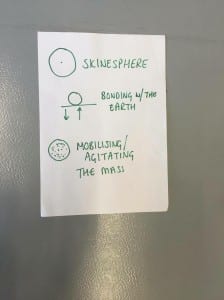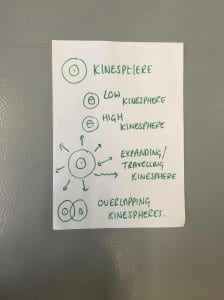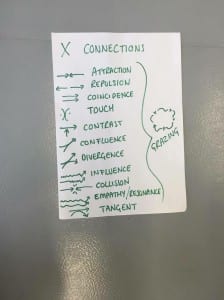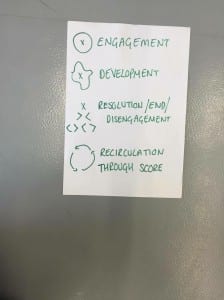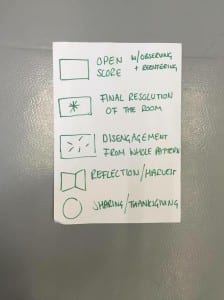Prior to class this week we were set two readings, one which discusses the audience and/or improviser relationship and the other reading which talks about criticism in relation to our practice. I found the first reading particularly interesting as it discusses how having an audience can sometimes effect the improvisation and that the energy/ intensity of your movement increases. Steve Paxton says that when he gets on stage he can “feel the change,” and that his “physical ability to move gets faster,” (De Spain, 2014, 60). I feel as though I can relate to this in some way because the pressure you get from an audience and how the audience perceives you, makes you want to work harder and perform your movement to the best of your ability. The second reading speaks about criticism and being able to criticise yourself in a way that will allow you to improve. Larry Lavender says “for improvisation to function well as a kind of pre-choreography training, it must be accompanied by training in criticism.” (Lavender, Predock-Linnell, 2011, 195). From this reading I got that criticism isn’t always a negative thing, it can be positive in the sense that it allows you to delve much deeper into improvisation and improve your movement pallet.
This week we began by working internally lying on our backs with our eyes closed. We really focused on the breath in this exercise taking care of our breathing and thinking only about our bodies. This allowed me to really check in with my body and made me aware of any tightness or discomfort I had in different areas. Focusing on just the body allowed me to feel the sensations of each body part and really focused me for the class ahead.
We were then asked to roll into a foetal position on both sides. When doing this I began to question how it felt, noticing how one side of the body felt a lot heavier than the other. We began doing this exercise faster, switching from left to right quite rapidly. This raised the heart rate and began working the abdominals and really woke and warmed the body up ready for the tasks ahead.
For the first improvisation exercise we began in a child’s pose position and went into a downwards dog and as a collective, we were asked to improvise movement on a lower kinesphere. I explored different ways of twisting my body pushing it to its furthest point before my body restricted me from going any further. I envisaged an elastic band being pulled one way and embodied this to really stretch my body . I also began to release and lift off an arm and a leg testing my balance and trying to make my body move into peculiar positions. As this exercise developed, the instructions changed and we had to lead movement from a specific body part, for example, the nose and elbow. When we were given the instruction of not being allowed to use a certain body part, like the arms or legs, this really restricted my movement and I began to question: where would I start my movement from? How will I move onto the floor without the use of one of my legs? This exercise was good for combatting the use of habitual movement and I noticed how different my movement started to look.
For the next exercise we walked around the space experimenting with stillness, pace and solo movement. This exercise was open, allowing us to improvise how we liked and move at a pace of our own accord. This exercise really brought me back into the room as the previous exercise was quite challenging.
We then split off into small groups and discussed Nancy Stark Smith’s ‘underscore.’ Stark describes the underscore as a “framework for practicing and researching dance improvisation.” (Stark-Smith, 2008, 90). Stark ‘rebelled,’ against what she knew and found herself “prolonging open, structure less sections of class,” where she would “suggest things to focus on through language and her own movement.” (Stark-Smith, 2008, 90). Students began referring to exercises as “that part of class,” as her classes didn’t follow a particular syllabus. It dawned on Smith that her random materials could be put together to make a “very consistent score.” (Stark-Smith, 2008, 90) And this is how it all began!
There are lots of “current phases” to the score, Stark Smith uses a range of symbols to show this, these are listed below:
When creating our own score we wanted to follow Anna Halprin’s RSVP cycle and use some of Smiths ideas in our work. We decided collectively that we wanted the group to be split into 3 smaller groups and that everybody would be improvising in the space but with different ‘set rules.’ We wanted our score to explore spatial relationships, dynamics and this idea of time (both felt time and active time). We also wanted to create a score which would combat habitual tendencies.
For group one’s score we used Stark-Smiths idea of ‘attraction.’ “Sensing a pull toward something or someone.” (Stark-Smith, 2008, 93). We left this score completely open to interpretation with the only rule being to be attracted to one person in the group and be repulsed by another. This set rule allowed the improviser to find connections between other people in the group. Observing this, we could see different rapports and relationships being formed, their tendencies being to compliment and copy.
For group two’s score we gave them imagery as they improvised on a high and low kinesphere; this we thought, would tackle habitual movement. From previously watching people improvise in class, using a low kinesphere in improvisation seems to be the one people feel most comfortable doing and is the most popular. We thought by asking the improvisers to work on a high and medium kinesphere it would really push them out of their comfort zone and that the improvisers would really start thinking of new movement. Some of our imagery included:
- Blades as arms
- Bouncy balls as legs
- Embody being a worm
- Embody being a shark
For groups three’s score we used Stark-Smiths idea of connection and touch. “Allowing physical contact between your body and another body or object.” (Stark-Smith, 2008, 93) We gave the improvisers a ball to work with as they passed the ball from person to person whilst improvising. To make it even more difficult, they weren’t allowed to use their hands and had to pass the ball using body parts such as the hips, the feet and the elbow. We thought this exercise would be quite challenging as they had to pass the object and think of how to improvise at the same time.
Every group had to improvise and find a moment of stillness when they thought a minute had passed. This tested thinking time and being able to play with the concept of time.
After observing this score, I believe we created something which was too complex and chaotic at times. After receiving feedback we had mixed reviews, people said they found the kinesphere score interesting because you had to ‘think outside the box.’ They also said that they questioned how they were going to move and work on a kinesphere that didn’t necessarily match the imagery. A lot of people found our score very difficult and concentrated on movement rather than time, this was evident near the end of the score as peoples focus dropped. Some people from the group said that the object score was quite distracting and trying to improvise and concentrate on improvising and moving the ball was challenging.
If I were to create our score again I would definitely simplify it to make it easier to understand and for people to follow!
I really enjoyed improvising other people’s scores, especially where we had to improvise with our eyes closed!
Bibliography-
De Spain, K. (2014) Landscape of the Now: The Audience/Improviser Relationship. New York: Oxford University Press. Pages 60-67
Lavender, L. and Predock-Linnell, J. (2011) From Improvisation to Choreography: the critical bridge. University of New Mexio, College of Fine Arts.
Stark Smith, N. (2008) Caught falling: the confluence of contact improvisation. Northampton, MA Contact Editions.

